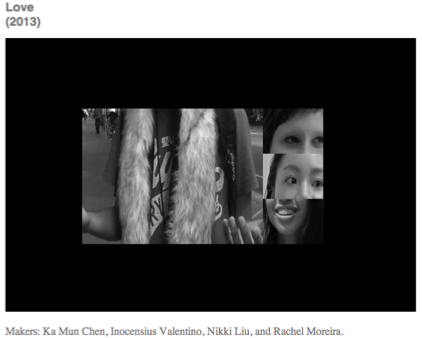FILM ESSAY – Korsakow film discussed available here: http://vogmae.net.au/classworks/2013/Love.html
The Korsakow film from 2013 entitled Love was created by Ka Mun Chen, Inocensius Valentino, Nikki Liu and Rachel Moreiro. This film demonstrates how simple technologies can be used to create and experiment with alternative narrative and non-narrative video. It incorporates one simple idea, what is love? And provides many different people’s various answers and interpretations on the topic.

Love makes use of quite a simple interface, adhering to Adrian Mile’s statement in his 2011 integrated media notes, that ‘just because you can use everything doesn’t mean you should.’ It’s use of a plain black background works well, as the video and images on the screen are vivid against it. The interface includes a single screen with three previews to the right of the main viewing window. This Korsakov film also is simple with its interface, as it does not incorporate any background soundtrack, just having the sound of the subjects on screen’s voices. The decision to create the film in this way allows for the audience to fully embrace what is being discussed in each video, as the people talking and the opinions they are talking about are the main focus of the film. Love also includes a ‘continue’ and ‘replay’ button at the finish, a creative interface decision that gives the viewer another choice when watching.
Love relies on three patterns that are obvious to the eye and that help make the interactive film flow in a simple way. As the film is fully based on people discussing their thoughts on a topic, the patterns evident include repetition with shot selection, as some of the people on screen are shown with their faces purposefully cut out of the shot when being filmed. Others include people having only their noses to their chins shown on screen when talking, and others have only an extreme close up of their eyes being shown.

These patterns play a role in the way the audience receives and interprets Love, with the interface having three preview screens, the audience is able to interact and engage with the film based on such patterns if they chose too. For example, when watching this Korsakow film for the first time, after one video finished I was more inclined to continue my viewing by clicking on one of the previews that had a similar shot structure to the one I just watched. This being said however, it is also possible that the creators intended for the opposite effect on the audience, wanting them to view different scaled shots after each other.
Within Love the interface and patterns present work together to portray the content to an audience in an easy to understand manner. The film is based on its title, Love, as it tries to get various people to express what love is to them and what they think love means within the context of the world. This is done by incorporating speech and creating a number of videos where males and females, most prominently in their late teens to mid twenties, individually discuss and talk about their thoughts on love. Some of the answers given are quite deep and meaningful, such as this quote from one woman in the film, ‘love is a word that I think you can apply to everything and nothing at the same time.’ As this is a non-linear film, it is evident that there is no story line or sequence of events, just a film purely based on peoples various thoughts that can be read by different audiences through their interaction with it. As Love is multilinear, it can begin anywhere and end anywhere, meaning that every person who watches and interacts with the film can have differing viewing experiences, some watching and hearing all about how great love is, others getting mixed feelings towards love, and others possibly hearing about how love is something that has no explanation.
Love gives it’s viewer an interactive look into the way people perceive the concept of love, and it does this quite well through the use of Korsakow. It’s evident patterns and it’s simple interface work together to create a film that enables its viewer to control what they see on screen, however not allowing them to control what opinions they hear or what particular kind of thoughts on ‘what love is’ that they will be presented with.


